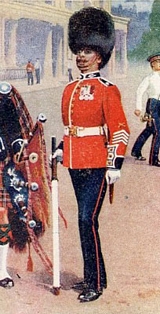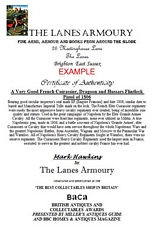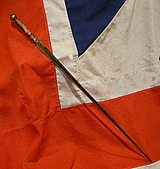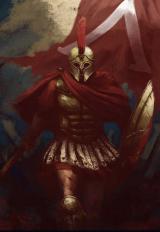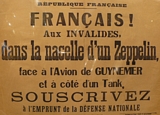A Most Scarce WW1 Scot's Guardsman's Tunic, Part of The British Monarch’s Personal Guard
Tunic in traditional red with brass buttons. The centre regiment of the five Guards Regiments of the Household Div. The Scots Guards have over three hundred and sixty years of unbroken service to the crown. They can trace their origins back to an army that was raised by Archibald 1st Marquess of Argyll, 16 March 1642. Since this date the Regiment has served in nearly every campaign in which the British Army has been involved in. In 1686 they were brought onto the establishment of the English Army for the first time. Eight years later they took precedence within the Foot Guards, despite their seniority by length of service. The Battle Honours of the Regiment are;
Namur 1695, Dettingen, Lincelles, [Egypt]1, Talavera, Barrosa, Fuentes d?Onor, Salamanca, Nive, Peninsula, Waterloo, Alma, Inkerman, Sevastopol, Tel-el-Kebir, Egypt 1882, Suakin 1885, Modder River, South Africa 1899-1902
First World War: Retreat from Mons, Marne 1914, Aisne 1914, Ypres 1914 ?17, Langemarck 1914, Gheluvelt, Nonne Bosschen, Givenchy 1914, Neuve Chapelle, Aubers, Festubert 1915, Loos, Somme 1916 ?18, Flers-Courcelette, Morval, Pilckem, Poelcappelle, Passchendaele, Cambrai 1917 ?18, St. Quentin, Albert 1918, Bapaume 1918, Arras 1918, Drocourt-Qu?ant, Hindenburg Line, Havrincourt, Canal du Nord, Selle, Sambre, France and Flanders 1914-18
Second World War: Stien, Norway 1940, Mont Pincon, Quarry Hill, Estry, Venlo Pocket, Rhineland, Reichswald, Cleve, Moyland, Hochwald, Rhine, Lingen, Uelzen, North-West Europe 1944-45, Halfaya 1941, Sidi Suleiman, Tobruk 1941, Gazala, Knightsbridge, Defence of Alamein Line, Medenine, Tadjera Khir, Medjez Plain, Grich el Oued, Dejbel Bou Aoukaz 1943 I, North Africa 1941-43, Salerno, Battipaglia, Volturno Crossing, Roccheta e Croce, Monte Camino, Anzio, Campoleone, Carroceto, Trasimene Line, Advance to Florence, Monte San Michele, Catarelto Ridge, Argenta Gap, Italy 1943-45
Honours since the Second World War;
Tumbledown Mountain, Falkland Islands 1982, Gulf 1991 read more
465.00 GBP
Every Original Purchase Comes With Our Unique Certificate of Authenticity
It will certify every piece as genuine, and further detail its area and era of use in its history, any conflicts and campaigns within which it may have been used, and all and any of its personal provenance if known. read more
Price
on
Request
An 18th Long, Boot or Cloak Sword
Cast brass hilt with relief figural decoration, and hawthorn wood grip. Steel rapier blade with engraving and deep fuller. Circa 1750. The knuckle bow and guard have been purposefully removed and the hilt re-attached. We had one quite similar, around 20 years ago, which came with an old article from a Connoisseur journal, It described, what was called, a boot or cloak sword. In the days of the threat by highwaymen, when a gentleman may have the need to consistently travel from town to town on horseback, but not by mail coach, a constant traveler might adapt a sword that could be easily slotted into knee high riding boots, or slipped into an especially constructed sleeve inside a riding cloak. For in wet and inclement weather a gentleman's flintlock pistol could not function, so without a sword for protection he was dangerously defenseless. Naturally a standard rapier short sword would be more normal, but on occasion, a gentleman that traveled constantly, or journeyed on perilous pursuits [such as a revenue man] might require a more concealable sword that would be far more easily manageable on both horseback or on foot. It also has the unique advantage of being eminently useable as a short distance spear type weapon, as it's weight balance is now very effective for that alternate purpose. 29.75 inches long overall read more
295.00 GBP
A WW2 German Druck Zunder 35 Fuse
Stamped “dkt 4”. This fuse was used on a variety of German mines including Anti Personnel, Behelfs Brettstckmine, Aluminium AT mines, Haft Hohlladung 3, and several improvised mines and demolition charges, also used as the main igniter in the heavy antitank mine M35610/99. Good condition. This is inert legal and safe to own in the UK. Not suitable for export read more
90.00 GBP
An Officer's Cap Badge of the Northamptonshire Regt. WW2
In silver metal and gilt. With battle honour scrolls of Gibralter and Talavera. Silver coloured metal, not hallmarked English silver. read more
95.00 GBP
A Koto to Shinto Period Katana Tsuba In Iron Pierced With Stylized Birds
The piercing has been outlined with a borderline of inlaid brass. Circa 1600. Tsuba were made by whole dynasties of craftsmen whose only craft was making tsuba. They were usually lavishly decorated. In addition to being collectors items, they were often used as heirlooms, passed from one generation to the next. Japanese families with samurai roots sometimes have their family crest (mon) crafted onto a tsuba. Tsuba can be found in a variety of metals and alloys, including iron, steel, brass, copper and shakudo. In a duel, two participants may lock their katana together at the point of the tsuba and push, trying to gain a better position from which to strike the other down. This is known as tsubazeriai pushing tsuba against each other. read more
465.00 GBP
Wonderous Pieces Added Every Day & There is Probably Nowhere Else In The World You Can View Such Fabulous Wonders, & Where Everything Is For Sale
Under one roof, from a rare American Civil War Revolver used in the U.S. Navy, and by cavalry of both the North and the South. An Original, Huge, WW2 Shell from A German King Tiger Tank, to an Original Imperial Roman Legionary’s Gladius, to a Museum Quality Samurai Sword by on of the great makers of early Japan. These past three weeks we have added, and are still adding, original, ancient classical edged weapons, from Rome, Carthage, Persia, Greece, and Scandinavia, from fine English collection/s [acquired in the 1990’s or before] including; a 2000 year old gladius from the time of Julius Caesar to Augustus to Nero. A museum grade 1000+ year old Viking chieftain [king] or earl’s [jarl] sword inlaid with knotwork silver inlay. A bronze and iron Archemeanid sword from the time of the Greco-Persian wars of Xerxes the Great against the Spartans at Thermopylae. An Imperial Roman 1st century ring, the type as worn by the Imperial Pretorian Guard with the symbol of a lion, from the time of the Emperors Augustus, Tiberius, Caligula, Claudius and Nero. A superb 3rd to 4th century BC Falcata sword similar to the Greek Kopis, the sword used by Hannibal’s army in the 2nd Punic War and his invasion of Rome across the Alps, and a 3rd Century Imperial Roman Sword, from the time of Emperor Constantine and the Battle of Cibalae. Plus a remarkable 1066 period Original Norman Iron Four Plate Helmet, [as Seen Depicted in the world famous so-called Bayeux Tapestry] & two early Books, one, an original 5th century Roman treatise on Roman warfare, and 18th Century biography on 18th century Warfare. Plus, as usual, many more pieces of historical interest. read more
Price
on
Request
An Original French Bond Poster 1917-18. Subscribe to the National Defence
Francais aux invalides dans la narcelle d'un zeppelin face a l'avion de Guynemer et a cote d'un tank souscrivez a l'emprunt de la defense national. A poster of an exhibition at the great French museum Les Invalides. In the square in front of the museum there was exhibited; a narcelle from a shot down Zeppelin, WW1 French ace Guynemer's plane, and a tank. Backed on to linen, from the American Forbes Library. read more
265.00 GBP
A Simply Superb Master Conductor/Composer's Solid Silver Presentation Baton
For those with an interest in presentation pieces in the realm of musical memorabilia. Engraved 'Geisha', O.M. [Order of Merit] 25th April 1925. C.A.O.S. [Choral & Orchestra Society]. In mallacca and mounted in hallmarked solid silver. Presentation gifted to a composer/conductor who would have been a contemporary of Sir Edward Elgar O.M. Sadly, we know not to whom it may have been presented. However research in the right quarter may well bear fruit. Unscrews at the midsection into two pieces. Superb quality as one might expect. read more
185.00 GBP
A Fabulous Imperial German Air Service Flask & Cigarette Case
This is just the epitome of all things Imperial German from the time of Kaiser Willhelm and Baron von Richthofen. The reservists flask was a peculiarly German artifact, and alongside the bier stein absolutely typical of the Germanic age of the early 20th century. The flask is an alloy depicting an embossed Zeppelin, an embossed plane and another, an anchor and a panel for luftschiff reserve service, and a similar for the flieger reserve service. It has a mono plane cup holder with a young pilot and his fraulein drinking and reveling. The front panel opens on a hinge revealing a picture behind the flask and a holder for cigarettes. It has wear and aging, but for the Imperial German WW1 reservist flask and stein collector you could probably not find a better or more desirable example. Overall 9 inches tall by 5 inches wide by 2 inches deep read more
395.00 GBP


